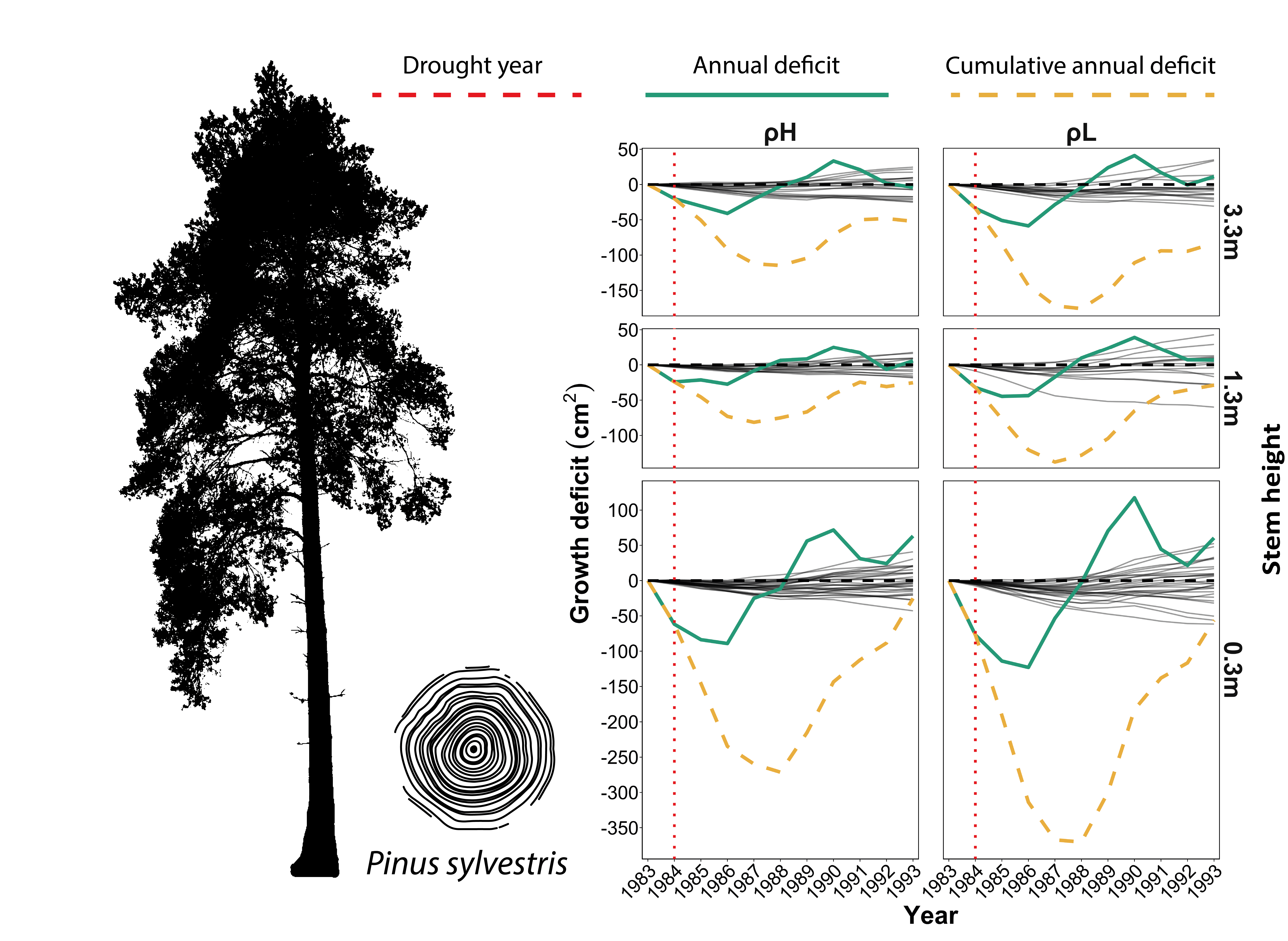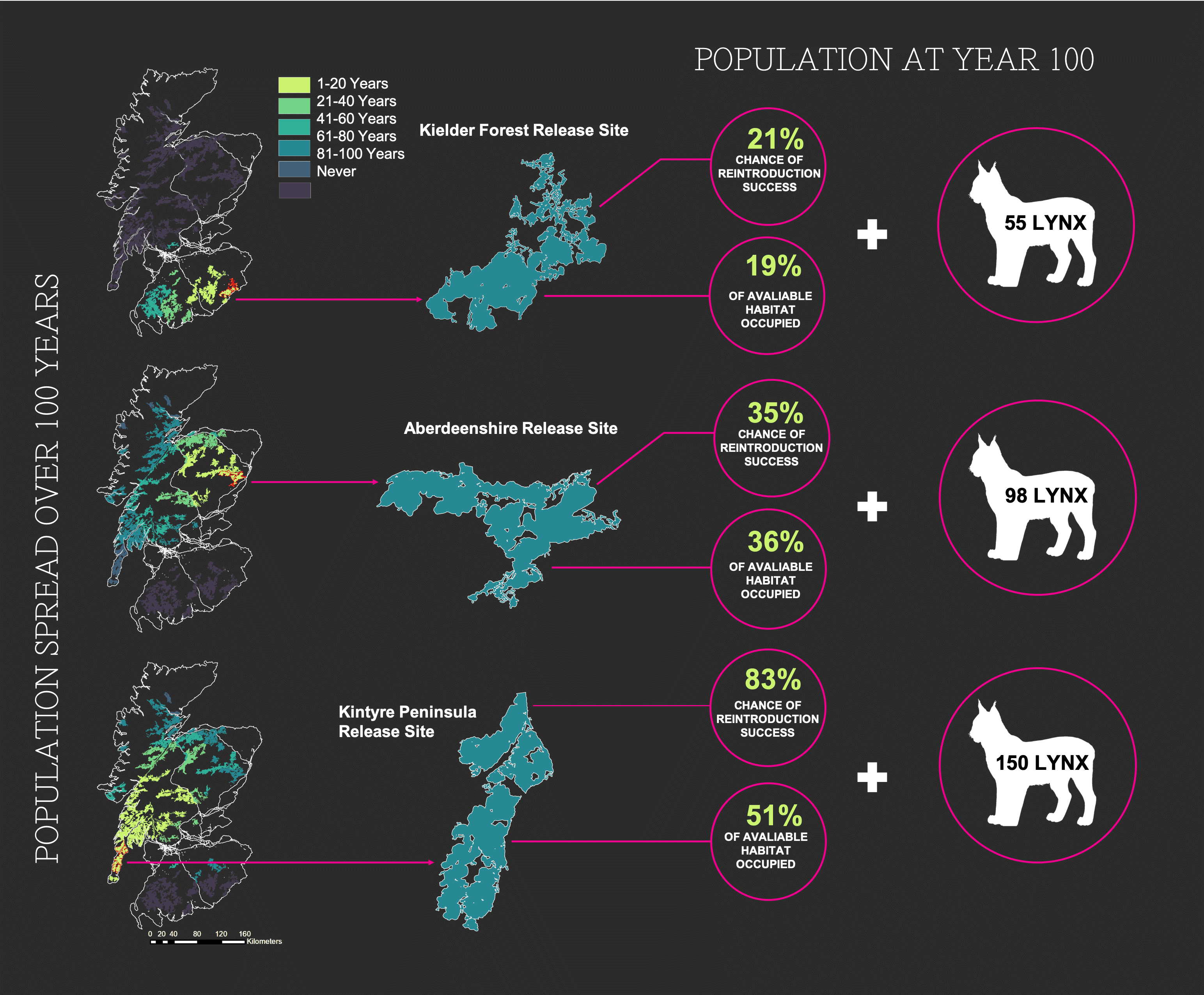MY PUBLICATIONS
LIFE AFTER RECOVERY: INCREASED RESOLUTION OF FOREST RESILIENCE ASSESSMENT SHEDS NEW LIGHT ON POST‐DROUGHT COMPENSATORY GROWTH AND RECOVERY DYNAMICS
JOURNAL PUBLICATION:
DIGESTIBLE SUMMARY
- With climate change set to increase the frequency, intensity and duration of future extreme drought events, understanding the impact of drought on forest productivity and the post-drought recovery dynamics of these systems is becoming increasingly important.
- Current approaches to quantifying resilience limit our understanding of forest response dynamics, recovery trajectories and drought legacies by constraining and simplifying the temporal scale and resolution of assessment.
- We developed an alternative approach to capture each individual tree’s relationship between climate and growth, which was then used to forecast tree growth annually for the drought year and nine subsequent years, in a scenario where no drought had occurred.
- This approach allowed us to increase the temporal scale and resolution of resilience assessment and follow tree and stand level growth relative to a no-drought scenario throughout recovery and into a post-recovery phase, where we find evidence for significant compensatory growth.
- The existence of compensatory growth post-recovery reduced estimates of drought induced losses of radial growth, indicating that current approaches risk underestimating tree and stand resilience to drought and overestimate losses in above-ground biomass.
- Similarly, we provide evidence for a temporal dependency in the stage during recovery at which pre-drought tree and stand attributes such as growth rates, basal area and stand densities were associated with growth resilience.
- Our results have wide reaching implications for both forest management targeted at increasing resilience, carbon budgeting and our understanding of drought legacy.
ABSTRACT
- Understanding the impacts of extreme drought on forest productivity requires a comprehensive assessment of tree and forest resilience. However, current approaches to quantifying resilience limit our understanding of forest response dynamics, recovery trajectories and drought legacies by constraining the temporal scale and resolution of assessment.
- We compared individual tree growth histories with growth forecasted using dynamic regression at an annual resolution, allowing drought impact and individual tree and stand level recovery dynamics to be assessed relative to a scenario where no drought occurred. The novel application of this approach allowed us to quantify the cumulative impact of drought legacy on radial growth at multiple stem heights at different stand densities.
- We show that the choice of pre‐ and post‐drought periods over which resilience is assessed can lead to systematic bias in both estimates and interpretations of resilience indices. In contrast, measuring growth resilience annually revealed clear nonlinearities in tree and stand recovery trajectories. Furthermore, we demonstrate that the influence of pre‐drought attributes such as tree size, growth rates and stand densities on growth resilience were only detectable at certain stages of recovery. Importantly, we show that the legacy of drought on tree growth can become positive for some individuals, extending up to 9 years after the event such that post‐recovery growth can result in the reclamation of some lost tree and stand basal area.
- Synthesis. We demonstrate the importance of increasing the temporal scale and resolution of forest resilience assessment in order to understand both patterns and drivers of drought recovery. We highlight the shortcomings of collapsing growth response into a single average value and show how drought legacy can persist into a post‐recovery phase, even positively impacting the growth of some trees. If unaccounted for, this post‐recovery growth phase can lead to an underestimation of resilience and an overestimation of above‐ground losses in productivity, highlighting the importance of considering longer‐term drought legacies and compensatory growth on basal area.
METRICS
KEY HIGHLIGHTS
- Current approaches to assessing forest resilience to drought risk limit our understanding of how forests recover.
- By extending the temporal scale and resoloution of resilience assessment using a new approach, we document patterns of ‘compensatory growth’ in some trees post-recovery.
- This compensatory growth was powerful enough to allow the forest to recover some of its lost biomass, meaning the impact of drought was less after 9 years than it was after 4 years.
- This in turn may indicate that short term assessments of drought impact may risk underestimating forest resilience and overestimating total drought impact on forest growth.
MEDIA COVERAGE
Press release:
Stirling University & British Ecological Society
Science media coverage:
Phys.org, CREAF & The Conversation
Local, national & international media:
MENAFN, Forestry Journal, Countryside Magazine, NewsBreak, Woodlands, Corepaedia, Opera News, Yahoo News, Global Advisors, The Herald & Smart Water Magazine
Blogs on this work:
European Forest Institute’s Resilience Blog, Journal of Ecology Blog & World Economic Forum
IMPROVING REINTRODUCTION SUCCESS IN LARGE CARNIVORES THROUGH INDIVIDUAL-BASED MODELLING: HOW TO REINTRODUCE EURASIAN LYNX (LYNX LYNX) TO SCOTLAND
JOURNAL PUBLICATION:
Ovenden, T.S., Palmer, S.C.F., Travis, J.M.J., Healey, J.R., 2019. Improving reintroduction success in large carnivores through individual-based modelling: How to reintroduce Eurasian lynx (Lynx lynx) to Scotland. Biol. Conserv. 234, 140–153. doi:10.1016/j.biocon.2019.03.035
POLICY BRIEF:
Ovenden, T.S, 2019. The potential for lynx reintroduction to Scotland Innovative modelling provides robust scientific evidence to inform decision making. doi: 10.13140/RG.2.2.35390.84806
DIGESTIBLE SUMMARY
- The Eurasian Lynx is being considered for reintroduction to Scotland having become extinct in the UK at the end of the medievil period due to habitat loss, persecution from hunting and a lack of roe deer – their favourite prey.
- We used detailed, up to date information on all of the different habitats across Scotland to generate high resolution maps of possible lynx habitat.
- We then used a sophisticated new model RangeShifter, that takes into account complex species behaviours across complex landscapes to model a reintroduction from three previously identified locations; Kielder Forest, Aberdeenshire and the Kintyre peninsula.
- We modelled each reintroduction for 100 years and averaged the results from 100 replicates.
- The Kintyre Peninsula performed best and Kielder Forest the worst, offering an 83% and 21% chance of establishing a healthy population of lynx respectively.
- Two distinct habitat networks were identified, one in the north, one in the south, separated by two major cities and road networks, making this a significant barrier to the movement of animals after release and to the colonisation of suitible habitat.
- This model can be used to inform the debate surrounding the reintroduction of lynx to Scotland and improve the chance of large carnivore reintroductions succeeding elsewhere in the world.
ABSTRACT
Globally, large carnivores have been heavily affected by habitat loss, fragmentation and persecution, sometimes resulting in local extinctions. With increasing recognition of top-down trophic cascades and complex predator-prey dynamics, reintroductions are of growing interest for restoration of ecosystem functioning. Many reintroductions have however failed, in part due to poor planning and inability to model complex eco-evolutionary processes to give reliable predictions. Using the case study of Eurasian lynx (Lynx lynx), a large predator being considered for reintroduction to Scotland, we demonstrate how an individual-based model that integrates demography with three distinct phases of dispersal (emigration, transfer and settlement) can be used to explore the relative suitability of three geographically-distant potential reintroduction sites, multi-site reintroductions and two founding population sizes. For a single-site reintroduction of 10 lynx, our simulation results show a clear hierarchy of suitability across all metrics. Reintroduction in the Kintyre Peninsula (west coast) consistently performed best, with a probability of population persistence at year 100 of 83%, and the Scottish component of Kielder Forest (southern Scotland) worst, with only a 21% chance of population persistence to year 100. Simultaneous two-site reintroduction in the Kintyre Peninsula and in Aberdeenshire (near the east coast) of 32 lynx gave a 96% persistence at 100 years. Our model was highly sensitive to survival, particularly of adults, highlighting this parameter’s importance for reintroduction success. The results strongly indicate the potential viability of Eurasian lynx reintroduction to Scotland given the current cover of suitable woodland habitat. More generally, our work demonstrates how emerging modelling approaches incorporating increased realism in representing species’ demography, ecology and dispersal can have high value for quick, inexpensive assessment of likely reintroduction success and for selection between alternative strategies.
KEY HIGHLIGHTS
- IBM approaches that integrate stochastic movement trajectories with population dynamics modelling across heterogeneous landscapes provide greater realism in reintroduction modelling.
- This modelling approach enables the quick and effective assessment of alternative reintroduction proposals and management scenarios.
- The contribution of this modelling approach could significantly improve the probability of reintroduction successes, especially of large carnivores.
- This case study demonstrates the suitability of existing habitat in Scotland for the reintroduction of Eurasian lynx but that appropriate site selection is key to success.
MEDIA COVERAGE
Press release:
Stirling University & Bangor University
Science media coverage:
Phys.org, ScienceDaily , IFL Science, Wildlife Articles, Universal Science, & The Conversation
Local, national & international media:
The Telegraph, The Evening Express, The Times, The Herald Scotland, Tunisiesoir, European Union News, The Daily Express, STV News, The Guardian
METRICS
THE PREVALENCE AND SOURCE OF PLASTIC INCORPORATED INTO NESTS OF FIVE SEABIRD SPECIES ON A SMALL OFFSHORE ISLAND
JOURNAL PUBLICATION:
Thompson D.L., Ovenden T.S., Pennycott T., Nager R.G., 2020. The prevalence and source of plastic incorporated into nests of five seabird species on a small offshore island. Mar Pollut Bull 154:111076. doi: 10.1016/j.marpolbul.2020.111076
ABSTRACT
There is little evidence documenting the prevalence of plastic nest incorporation for different seabird species and populations, and even less detailing the source of such debris as nesting material. This study presents a baseline dataset on the presence of plastic in the nests of five seabird species on Lady Isle, Scotland using a novel and repeatable methodology for quantifying plastic incorporated into nests. Plastic was found in 24.5% to 80% of nests of all species. We analysed pellets of regurgitated material and the spatial distribution of herring gull nests containing plastic in the context of the tide and nesting habitat. Differences in the types of plastic found in pellets and nests suggests that plastic incorporated into herring gull nests was not derived at foraging sites and likely collected from the local environment. Targeted beach cleans before the breeding season could help minimise the quantity of plastic available to herring gulls.
METRICS
KEY HIGHLIGHTS
-
Research on the source and quantity of plastic in seabird nests is currently rare.
- In this study, we assessed the prevalence and quantity of plastic in 5 species of seabird on an uninhabited island in south west Scotland.
-
The proportion of nests with plastic was >25% and varied between species.
- Nest plastic was likely from the local environment rather than regurgitated pellets.
MEDIA COVERAGE
Press release:
Science media coverage:
Phys.org, Inside Ecology, The Ecologist, My Science, Birds on the Edge & The Conversation
Local, national & international media:
Sky News, The Evening Express, Big News Network, The Times, The Daily Mail, The Independent, The Scotsman, iNews & The Express and Star

 https://orcid.org/0000-0002-6957-1333
https://orcid.org/0000-0002-6957-1333

